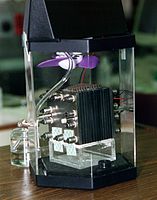
Photo from wikipedia
Abstract Synthesis of electrocatalysts with excellent performance for hydrogen and oxygen evolution are the main challenges for production of hydrogen by electrochemical water splitting method. Here, Ni–Mo nanostars were created… Click to show full abstract
Abstract Synthesis of electrocatalysts with excellent performance for hydrogen and oxygen evolution are the main challenges for production of hydrogen by electrochemical water splitting method. Here, Ni–Mo nanostars were created by electrochemical deposition process at different morphologies and their electrocatalytic behavior was studied for hydrogen and oxygen evolution reactions in 1.0 M KOH solution. Increased electrochemically active surface area due to the nanostars formation, improved intrinsic electrocatalytic activity, increased surface wettability, as well as being binder-free during electrode production, resulted in excellent electrocatalytic behavior. For optimized condition, 60 mV and 225 mV overpotential are needed for generating the current density of 10 mA.cm-2 in HER and OER process respectively in the alkaline medium. The lower slope of the electrode compared to the other electrodes also indicated that the kinetics of HER on the surface of the electrode was better. Also, there was very little change in the potential during the stability test, indicating the excellent electrocatalytic stability of the synthesized electrode. The present study introduces a rational, cost-effective and binder-free method for the synthesis of high performance electrocatalysts.
Journal Title: International Journal of Hydrogen Energy
Year Published: 2020
Link to full text (if available)
Share on Social Media: Sign Up to like & get
recommendations!